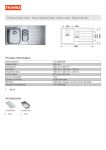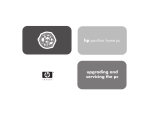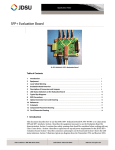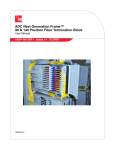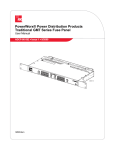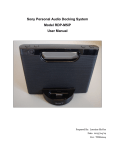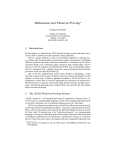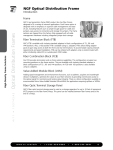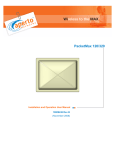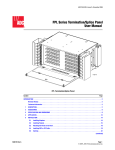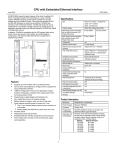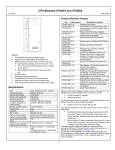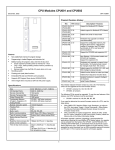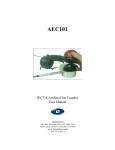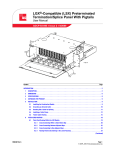Download LGX Compatible (LSX) Connector Module User Manual)
Transcript
ADCP-93-089 • Issue 3 • March 2002 LGX Compatible (LSX) Connector Module User Manual) 17506-A LSX Connector Module Content Page INTRODUCTION . . . . . . . . . . . . . . . . . . . . . . . . . . . . . . . . . . . . . . . . . . . . . . . . . . . . . . . . . . . . . . . . . . . . . . . . . . . . . 2 Revision History . . . . . . . . . . . . . . . . . . . . . . . . . . . . . . . . . . . . . . . . . . . . . . . . . . . . . . . . . . . . . . . . . . . . . . . . 2 Trademark Information . . . . . . . . . . . . . . . . . . . . . . . . . . . . . . . . . . . . . . . . . . . . . . . . . . . . . . . . . . . . . . . . . . . 2 Related Publications . . . . . . . . . . . . . . . . . . . . . . . . . . . . . . . . . . . . . . . . . . . . . . . . . . . . . . . . . . . . . . . . . . . . . 2 1 DESCRIPTION . . . . . . . . . . . . . . . . . . . . . . . . . . . . . . . . . . . . . . . . . . . . . . . . . . . . . . . . . . . . . . . . . . . . . . . . . . 3 2 DIMENSIONS AND SPECIFICATIONS . . . . . . . . . . . . . . . . . . . . . . . . . . . . . . . . . . . . . . . . . . . . . . . . . . . . . . . . . . 7 3 UNPACKING THE PRODUCT . . . . . . . . . . . . . . . . . . . . . . . . . . . . . . . . . . . . . . . . . . . . . . . . . . . . . . . . . . . . . . . . 9 4 INSTALLATION . . . . . . . . . . . . . . . . . . . . . . . . . . . . . . . . . . . . . . . . . . . . . . . . . . . . . . . . . . . . . . . . . . . . . . . . 10 5 4.1 Installing the Connector Module . . . . . . . . . . . . . . . . . . . . . . . . . . . . . . . . . . . . . . . . . . . . . . . . . . . . . . 10 4.2 Installing a VAM . . . . . . . . . . . . . . . . . . . . . . . . . . . . . . . . . . . . . . . . . . . . . . . . . . . . . . . . . . . . . . . . . 11 4.3 Breaking Out a Cable . . . . . . . . . . . . . . . . . . . . . . . . . . . . . . . . . . . . . . . . . . . . . . . . . . . . . . . . . . . . . . 11 4.4 Installing a Cable Clamp . . . . . . . . . . . . . . . . . . . . . . . . . . . . . . . . . . . . . . . . . . . . . . . . . . . . . . . . . . . 13 CABLE ROUTING AND REPLACEMENT . . . . . . . . . . . . . . . . . . . . . . . . . . . . . . . . . . . . . . . . . . . . . . . . . . . . . . . . 16 5.1 Routing Stranded Cable . . . . . . . . . . . . . . . . . . . . . . . . . . . . . . . . . . . . . . . . . . . . . . . . . . . . . . . . . . . . 17 5.2 Routing Ribbon Cable . . . . . . . . . . . . . . . . . . . . . . . . . . . . . . . . . . . . . . . . . . . . . . . . . . . . . . . . . . . . . 17 5.3 Routing Quad Cable (Two Active Fibers, Two Spare Fibers) . . . . . . . . . . . . . . . . . . . . . . . . . . . . . . . . . . . . 18 (continued) 1220595 Rev A Page 1 © 2003, ADC Telecommunications, Inc. ADCP-93-089 • Issue 3 • March 2002 Content 6 7 Page 5.4 Replacing a Single Fiber or Fiber Pair Termination . . . . . . . . . . . . . . . . . . . . . . . . . . . . . . . . . . . . . . . . . 19 5.5 Replacing a Quad Cable . . . . . . . . . . . . . . . . . . . . . . . . . . . . . . . . . . . . . . . . . . . . . . . . . . . . . . . . . . . . 20 PATCH CORD ROUTING . . . . . . . . . . . . . . . . . . . . . . . . . . . . . . . . . . . . . . . . . . . . . . . . . . . . . . . . . . . . . . . . . . 21 6.1 Patch Cord Routing Within the LSX Module. . . . . . . . . . . . . . . . . . . . . . . . . . . . . . . . . . . . . . . . . . . . . . . 21 6.2 Routing Patch Cords on the LGX Bay . . . . . . . . . . . . . . . . . . . . . . . . . . . . . . . . . . . . . . . . . . . . . . . . . . . 22 Cross-Connecting Within a Stand-Alone Bay . . . . . . . . . . . . . . . . . . . . . . . . . . . . . . . . . . . . . . . 22 6.2.2 Cross-Connecting Between Adjacent Bays . . . . . . . . . . . . . . . . . . . . . . . . . . . . . . . . . . . . . . . . 24 6.2.3 Cross-Connecting to Non-Adjacent Bays . . . . . . . . . . . . . . . . . . . . . . . . . . . . . . . . . . . . . . . . . . 25 6.2.4 Routing Patch Cords Starting in the Lower Raceway . . . . . . . . . . . . . . . . . . . . . . . . . . . . . . . . . 26 6.2.5 Routing Patch Cords Starting in the Upper Raceway. . . . . . . . . . . . . . . . . . . . . . . . . . . . . . . . . . 28 6.3 Mounting 144-Position Modules Adjacent to 72 or 96 Position Modules . . . . . . . . . . . . . . . . . . . . . . . . . . . 30 6.4 Installing Modified Cable Retainers for 144-Position Modules. . . . . . . . . . . . . . . . . . . . . . . . . . . . . . . . . . 32 OPERATION . . . . . . . . . . . . . . . . . . . . . . . . . . . . . . . . . . . . . . . . . . . . . . . . . . . . . . . . . . . . . . . . . . . . . . . . . . 33 7.1 8 6.2.1 Removing a Cover for Easier Access . . . . . . . . . . . . . . . . . . . . . . . . . . . . . . . . . . . . . . . . . . . . . . . . . . . 33 7.2 Patching and Testing . . . . . . . . . . . . . . . . . . . . . . . . . . . . . . . . . . . . . . . . . . . . . . . . . . . . . . . . . . . . . . 33 7.3 Cleaning Connectors and Adapters . . . . . . . . . . . . . . . . . . . . . . . . . . . . . . . . . . . . . . . . . . . . . . . . . . . . 33 CUSTOMER INFORMATION AND ASSISTANCE . . . . . . . . . . . . . . . . . . . . . . . . . . . . . . . . . . . . . . . . . . . . . . . . . . . 34 _________________________________________________________________________________________________________ INTRODUCTION This user manual describes the ADC LGX Compatible (LSX) Connector Module, and provides instructions for installation and operation. The LSX connector module is designed to be mounted on either a 19 inch (48.26 cm) or 23 inch (58.42) Lucent LGX compatible rack. Revision History quad cables and patch cord routing ISSUE DATE REASON FOR CHANGE Issue 1 06/2001 Original. Issue 2 07/2001 Incorporate description of quad cables and patch cord routing. Issue 3 04/2002 Updated to provide additional information on different chassis sizes and types. Trademark Information ADC is a registered trademark of ADC Telecommunications, Inc. LGX is a registered trademark of Lucent Technologies. Related Publications Title LGX Compatible (LSX) Combination Termination/Splice Module User Manual Page 2 © 2003, ADC Telecommunications, Inc. ADCP Number 93-095 ADCP-93-089 • Issue 3 • March 2002 1 DESCRIPTION The LSX connector module is an LGX compatible, rack-mounted termination panel. It provides a physical interface between fiber optic cables (terminated on the rear side of the bulkhead) and patch cords (terminated on the front). In a typical application, cables from transmission facilities are patched to fiber optic terminal equipment. The LSX connector module may be used in either an interconnect or cross-connect configuration, in either single mode or multimode applications, and with either stranded or ribbon cable. The cables may be either Intrafacility Fiber (IFC) or Outside Plant (OSP). The LSX connector module is available in three chassis heights: 7-inch, 9-inch, and 10-inch. The 7-inch chassis can be ordered with either 72 or 96 fiber termination positions. The 9-inch chassis has 144 positions. The 10-inch chassis has 216 positions. In addition, the 7-inch, 72 position module can be ordered in a double stack configuration providing 144 positions or in a triple stack configuration providing 216 positions; the 9-inch module can be ordered in a triple stack configuration providing 432 positions. Figure 1 and Figure 2 show the main external features of the 7-inch, 72 position module and the 9-inch, 144 position module, respectively. LGX COMPATIBLE CHASSIS BULKHEAD CONNECTOR PACK MOUNTING BRACKET PATCH CORD GUIDE REMOVABLE FRONT COVER PATCH CORD DESIGNATION CARD REMOVABLE RADIUS LIMITERS 17424-A Figure 1. Main External Features of 7-Inch, 72-Position LSX Connector Module Page 3 © 2003, ADC Telecommunications, Inc. ADCP-93-089 • Issue 3 • March 2002 LGX COMPATIBLE CHASSIS BULKHEAD CONNECTOR PACK MOUNTING BRACKET PATCH CORD GUIDE REMOVABLE FRONT COVER PATCH CORD DESIGNATION CARD REMOVABLE RADIUS LIMITERS 17509-A Figure 2. Main External Features of 9-Inch, 144 Position LSX Connector Module The main features are similar for each chassis type shown. They are as follows (going from top left clockwise in Figure 1 and Figure 2): • LGX Compatible Chassis—is of solid metal construction and painted white. The 72 position and 96 position LSX connector modules have a rack height of 7 inches (17.8 cm) and a maximum of nine of these modules can be installed in the LGX frame. The 144 position connector module has a rack height of 9 inches (22.9 cm) and a maximum of seven of these modules can be installed in the LGX frame. The 216 position connector module has a rack height of 10 inches (25.4 cm) and a maximum of six modules can be installed in the LGX frame. • Bulkhead—holds the pass-through adapters/connectors that provide the physical interface between cables and patch cords. • Connector Pack—6-pack (72 position LSX), 8-pack (96 position LSX), 12-pack (144 position LSX), or 18-pack (216 position LSX); mounts in the bulkhead, providing one column of adapter/connectors. Individual connector packs are easily installed or replaced. All standard connector types are available including FC, SC, FC, ST, LX.5, etc. Page 4 © 2003, ADC Telecommunications, Inc. ADCP-93-089 • Issue 3 • March 2002 • Patch Cord Guides—provide cable management in routing patch cords from connectors to each side. • Removable Front Cover—provides unimpeded access to connectors for installation of patch cords. • Patch Cord Designation Card—is used to record patch cord usage. • Removable Radius Limiters—maintain proper bend radius protection for the fibers. • Mounting Brackets—may be oriented to accommodate either 19-inch or 23-inch rack mount. The LSX connector module may be ordered loaded with connector packs only, or loaded with both connector packs and pre-terminated, factory-installed cable. While not recommended, field-installed connectors can be accommodated. Value-Added Modules (VAMs) are also available for the LSX module, providing functions such as multiplexing, splitting, and variable attenuation of optical signals. Figure 3 shows a rear view of the 72 position connector module. As shown, the module has cable guides for routing cable subunits to the rear connectors. The module also has a rear cable designation card on the inside of the rear cover. Figure 3. LSX Connector Module (Rear View) Page 5 © 2003, ADC Telecommunications, Inc. ADCP-93-089 • Issue 3 • March 2002 Figure 4 shows an example of a stacked configuration of three 7-inch, 72 position modules providing 216 termination positions. Other stack configurations (2 x 72 for 144 positions, 3 x 144 for 432 positions) are similar in design. Figure 5 shows the 10 inch, 216 position module. 17520-A Figure 4. Stacked Configuration of Three 7-Inch, 72 Position LSX Connector Modules Page 6 © 2003, ADC Telecommunications, Inc. ADCP-93-089 • Issue 3 • March 2002 17423-A Figure 5. 10-Inch High, 216 Position LSX Connector Module 2 DIMENSIONS AND SPECIFICATIONS Table 1 lists specifications. Figure 6 shows dimensions for the 7- and 9-inch modules. Figure 7 shows dimensions for the 10-inch module. Table 1. LSX Connector Module Specifications ITEM DESCRIPTION Height 72 and 96 position chassis: 7 inches (17.8 cm) 144 position chassis: 9 inches (22.86 cm) 216 position chassis: 10 inch (25.40 cm) 144 position double stack: 14 inches (35.56 cm) 216 position triple stack: 21 inches (53.34 cm) Width Depth 432 position triple stack: 27 inches (68.58 cm) 16.84 inches (42.8 cm) 11.00 inches (27.9 cm) Page 7 © 2003, ADC Telecommunications, Inc. ADCP-93-089 • Issue 3 • March 2002 Table 1. LSX Connector Module Specifications, continued ITEM DESCRIPTION Rack Mount Mounting bracket accommodates either 19-inch or 23-inch; 10inch chassis can be mounted with 4-inch or 5-inch recess 72 position LSX: 9 pounds (4.1 kg); 96 position LSX: 10 pounds (4.5 kg); 144 position LSX: 13 pounds (5.9 kg); 216 position LSX: 13 pounds (5.9 kg); 144 position double stack:18 pounds (8.2 kg); 216 position triple stack: 27 pounds (12.3 kg); 432 position triple stack: 39 pounds (17.7 kg) 72, 96, 144, or 216 per chassis (depending on type); stacks provide 144 (2 x 72), 216 (3 x 72), or 432 (3 x 144) terminations Weight (unloaded) Terminations 14.84 IN. (37.7 CM) 11.0 IN. (27.9 CM) 7.53 IN. (19.1 CM) 5.0 IN. (12.7 CM) 16.84 IN. (42.8 CM) 22.15 (56.3 CM) 23-IN. RACK MOUNT (58.4 CM) 18.12 (46.0 CM) 19-IN. RACK MOUNT (48.3 CM) 1.0 IN. (2.5 CM) 2.0 IN. (5.1 CM) 1 1.0 IN. (2.5 CM) 17422-A 1 7.0 IN. (17.8 CM) HEIGHT ON 72 OR 96 POSITION MODULES OR 9.0 (22.9 CM) HEIGHT ON 144 POSITION MODULES. Figure 6. Dimensions for 7-Inch and 9-Inch Modules Page 8 © 2003, ADC Telecommunications, Inc. ADCP-93-089 • Issue 3 • March 2002 14.84 IN. (37.7 CM) 11.0 IN. (27.9 CM) 7.54 IN. (19.2 CM) 5.0 IN. (12.7 CM) 16.84 IN. (42.8 CM) 22.15 (56.3 CM) 23-IN. RACK MOUNT (58.4 CM) 20.18 (51.3 CM) RECESSED 23-IN. RACK MOUNT (58.4 CM) 18.16 (46.1 CM) 19-IN. RACK MOUNT (48.3 CM) 1.0 IN. (2.5 CM) 10.0 IN. (25.4 CM) 2.0 IN. (5.1 CM) 1.0 IN. (2.5 CM) 17508-A Figure 7. Dimensions for 10-Inch Module 3 UNPACKING THE PRODUCT 1. Inspect the exterior of the shipping container for evidence of rough handling that may have damaged the contents of the container. 2. Unpack the module and accessories and check for possible damage. Page 9 © 2003, ADC Telecommunications, Inc. ADCP-93-089 • Issue 3 • March 2002 3. If damage is detected or if parts are missing, file a claim with the commercial carrier and then notify ADC Customer Service. Save damaged carton for inspection by the carrier. 4. Save the shipping container for use if equipment requires shipment at a future date. 4 INSTALLATION 4.1 Installing the Connector Module The LSX connector module is designed to be installed from the front side of the rack. To install the connector module, use the following procedure. 1. Determine the mounting location and rack width. For a 19-inch rack, remove the two mounting brackets and re-install them using the 19-inch orientation (refer to Figure 6 for 7- and 9-inch modules or Figure 7 for the 10-inch module). For a 23-inch rack, install the chassis with the mounting brackets positioned as shipped. 2. Secure the mounting brackets to the rack front flange using six #12-24 mounting screws, as shown in Figure 8. Note: If LGX jumper retainers are being used, remove them and reinstall them with the chassis as shown in Figure 8. The jumper retainers are not an ADC product. RACK FRONT FLANGE LGX JUMPER RETAINER (NOT PROVIDED BY ADC) MOUNTING BRACKET LGX JUMPER RETAINER (NOT PROVIDED BY ADC) 17510-A 12-24X SCREW (6) Figure 8. Installing the Connector Module (23-Inch Rack Shown) Page 10 © 2003, ADC Telecommunications, Inc. ADCP-93-089 • Issue 3 • March 2002 4.2 Installing a VAM If installing a Value Added Module (VAM) in the connector module, install it from the front side. To install a VAM, place it in the correct position with respect to the mounting holes and then press in the plunger expanders. Refer to Figure 9. MOUNTING HOLE PLUNGEREXPANDER 17544-A VAM MODULE Figure 9. Installing a VAM 4.3 Breaking Out a Cable If the module was shipped without a pre-terminated cable stub, the cable must be broken out corresponding to specified dimensions. For stranded cable, refer to Figure 10. Note: Figure 10 depicts an IFC cable. For OSP cable, use the same dimensions as shown for the IFC cable. A blocking kit is also recommended. The blocking kit is not shown. For IFC ribbon cable with 72, 96, or 144 fibers, refer to Figure 11. For IFC ribbon cable with 216 fibers, refer to Figure 12. For OSP ribbon cable, refer to Figure 12. Page 11 © 2003, ADC Telecommunications, Inc. ADCP-93-089 • Issue 3 • March 2002 BREAKOUT LENGTHS 7-IN. MODULE: 46.0 IN. (116.8 CM) 9-IN. MODULE: 48.0 IN. (121.9 CM) +0.0 IN./-6.0 IN. (+0.0 CM/-15.2 CM) FANOUT LENGTHS 7-IN. MODULE: 35.0 IN. (88.9 CM) 9-IN. MODULE: 37.0 IN. (94.0 CM) +0.0 IN./-6.0 IN. (+0.0 CM/-15.2 CM) 2.0 IN. (5.1 CM) IFC CABLE 17605-A SUBUNIT DESIGNATION LABEL HEATSHRINK 6.0 IN. (15.2 CM) CLAMP CONNECTORS Figure 10. Recommended Breakout Dimensions for Stranded Cable (IFC Shown) CLAMP POSITIONS BREAKOUT LENGTHS 7-IN. MODULE: 46.0 IN. (116.8 CM) 9-IN. MODULE: 48.0 IN. (121.9 CM) +0.0 IN./-6.0 IN. (+0.0 CM/-15.2 CM) 7-IN. MODULE: 48.0 IN. (121.9 CM) 9-IN. MODULE: 50.0 IN. (127.0 CM) +0.0 IN./-6.0 IN. (+0.0 CM/-15.2 CM) FANOUT LENGTHS 7-IN. MODULE: 36.5 IN. (92.7 CM) 9-IN. MODULE: 38.5 IN. (97.8 CM) +0.0 IN./-6.0 IN. (+0.0 CM/-15.2 CM) TUBING LENGTH 6.5 IN. –0.5 IN. (16.5 CM –1.3 CM) SUBUNIT DESIGNATION LABEL CLAMP 17543-A CONNECTORS Figure 11. Recommended Breakout Dimensions for 72-, 96-, or 144-Fiber IFC Ribbon Cable Page 12 © 2003, ADC Telecommunications, Inc. ADCP-93-089 • Issue 3 • March 2002 IFC CABLE INSTALL PROTECTIVE TUBES ON RIBBON TIE WRAP FANOUT CHIP INDIVIDUAL FIBERS END OF PROTECTIVE TUBE BREAKOUT LENGTHS CONNECTORS FANOUT LENGTHS 7-IN. MODULE: 36.5 IN. (92.7 CM) 9-IN. MODULE: 38.5 IN. (97.8 CM) 216-POS. MODULE: 41.5 IN. (105.4 CM) +0.0 IN./-6.0 IN. (+0.0 CM/-15.2 CM) 17507-A 7-IN. MODULE: 46.5 IN. (118.1 CM) 9-IN. MODULE: 48.5 IN. (123.2 CM) 216-POS. MODULE: 50.0 IN. (127.0CM) +0.0 IN./-6.0 IN. (+0.0 CM/-15.2 CM) Figure 12. Recommended Breakout Dimensions for 216-Fiber IFC Ribbon Cable And 72-, 96-, 144-, or 216-Fiber OSP Ribbon Cable 4.4 Installing a Cable Clamp After the cable has been prepared as described, a cable clamp can be installed using the following procedure. For names of cable clamp components, refer to Figure 13 for the 7-inch module and Figure 14 for the 9-inch module. Note: Figure 13 and Figure 14 show the cable clamp bracket positioned for cable routing from above the module with the bracket fastened using the two upper mounting holes in the cable mount plate. For cable routing from below the module, turn the cable clamp bracket upside down compared to how it is shown in the figure and use the two lower mounting holes in the cable mount plate. 1. Install the cable clamp bracket on the clamp mount plate using two #12-24 screws. Be sure to position the cable clamp bracket corresponding to the note above. Page 13 © 2003, ADC Telecommunications, Inc. ADCP-93-089 • Issue 3 • March 2002 2. Place the two standoffs in the standoff mounting holes in the cable clamp bracket. Note: There are four standoff mounting holes. Either the two holes on the left or the two holes on the right can be used together, not the two holes in the middle. STANDOFF MOUNTING HOLE (4) YOKE (2) STANDOFF (2) RUBBER GROMMET CABLE CLAMP COVER CABLE CLAMP BRACKET MOUNTING HOLES (2) FOR OVERHEAD CABLE ENTRY) CABLE CLAMP BRACKET MOUNTING HOLES (2) FOR UNDER FLOOR CABLE ENTRY) STANDOFF SCREW (2) 12-24X SCREW (2) 17512-A CABLE CLAMP BRACKET (OVERHEAD CABLE POSITION) Figure 13. Cable Clamp Components (7-Inch Module) Page 14 © 2003, ADC Telecommunications, Inc. CLAMP MOUNT PLATE ADCP-93-089 • Issue 3 • March 2002 YOKE (2) STANDOFF MOUNTING HOLE (4) RUBBER GROMMET STANDOFF (2) CABLE CLAMP COVER CABLE CLAMP BRACKET MOUNTING HOLES (2) FOR UNDER FLOOR CABLE ENTRY) CABLE CLAMP BRACKET MOUNTING HOLES (2) FOR OVERHEAD CABLE ENTRY) STANDOFF SCREW (2) CLAMP MOUNT PLATE 12-24X SCREW (2) CABLE CLAMP BRACKET (OVERHEAD CABLE POSITION) 17513-A Figure 14. Cable Clamp Components (9-Inch Module) 3. Two rubber yokes and either three or four grommets (depending on the kit) are provided with the cable clamp kit for securing the cable to the module. Select a grommet that, when placed around the cable as shown in Figure 15, results in a gap of approximately zero to 0.030 inches (8 mm), as shown. GROMMET CABLE GAP 0 - 0.30 IN. (0 - 8 MM) 1440-A Figure 15. Grommet Selection Page 15 © 2003, ADC Telecommunications, Inc. ADCP-93-089 • Issue 3 • March 2002 4. Stack the cable clamp components as shown in Figure 13 or Figure 14, with the cable secured within the rubber grommet. For correct location of the cable breakout, refer to the cable breakouts provided in subsection 4.3. 5. Secure the cable clamp components to the standoffs using standoff screws, as shown. 6. If desired, install a cable shield using any of the three shields shipped with the connector module. Figure 16 shows the shield used for overhead cable. (The package also contains an alternate shield used for under-floor cable and a box-shaped shield used with either overhead or under-floor cable.) CABLE CLAMP 17514-A CABLE SHIELD 4-40X SCREWS (2) Figure 16. Cable Shield Components (Shield Shown is Used With Overhead Cable) 5 CABLE ROUTING AND REPLACEMENT After preparing and clamping the cable as described in Section 4, above, you can route the cable fibers into the rear of the LSX module. For instructions, refer to the separate procedures below for stranded cable, ribbon cable, and quad cable. This section also contain instructions for replacing one or more cable fibers if necessary. Separate procedures are provided for a single fiber and quad cable. Page 16 © 2003, ADC Telecommunications, Inc. ADCP-93-089 • Issue 3 • March 2002 5.1 Routing Stranded Cable If a stranded cable is being installed, route the cable fibers into the rear of the LSX connector module using the following procedure (see Figure 17). 1. Position the cable breakout an inch (2.54 cm) after the cable clamp. 2. Route the subunits to the front center retainer, as shown, with the subunits broken out into individual fibers at that location. 3. Route the fibers around the retainers and then fan them out to the adapter ports, as shown in Figure 17. FROM OVERHEAD CABLE CLAMP FRONT CABLE BREAKOUT 1.0 IN. (2.54 CM) REF HEAT SHRINK SUBUNITS REAR LEFT CABLE CLAMP REAR CENTER RETAINER FRONT CENTER RETAINER INDIVIDUAL SUBUNIT RIGHT CABLE CLAMP BREAKOUT SUBUNIT HERE 17515-A Figure 17. Stranded Cable Routing – Top View 5.2 Routing Ribbon Cable If a ribbon cable is being installed, route the cable fibers into the rear of the LSX connector module using the following procedure (see Figure 18) 1. Position the cable breakout immediately after the cable clamp, as shown. Page 17 © 2003, ADC Telecommunications, Inc. ADCP-93-089 • Issue 3 • March 2002 2. Route the ribbons (within protective tubes) to the rear center retainer and secure the fanout chips at that location. 3. Route the fibers from the fanout chips around the retainers, then fan them out to the adapter ports, as shown in Figure 18. FROM OVERHEAD CABLE CLAMP FRONT CABLE BREAKOUT TIE WRAP PROTECTIVE TUBES REAR LEFT CABLE CLAMP FRONT CENTER RETAINER FANOUT CHIP REAR CENTER RETAINER INDIVIDUAL SUBUNIT RIGHT CABLE CLAMP 17516-A Figure 18. Ribbon Cable Routing – Top View 5.3 Routing Quad Cable (Two Active Fibers, Two Spare Fibers) If a quad cable is being installed, route one-half of the quad cable into the left side and the other half into the right side of the module (as shown in Figure 19). Quad cables entering the module from the left (when viewed from the rear) are terminated on the right half of the module. Quad cables entering the module from the right (when viewed from the rear) are terminated on the left half of the module. Use the following procedure. 1. Terminate each working pair of fibers to the appropriate adapter locations. 2. Route the fibers through the cable retainers in the module to the rear center retainer. 3. Route spare fibers around the retainers and allow them to lie in the bottom of the module. Page 18 © 2003, ADC Telecommunications, Inc. ADCP-93-089 • Issue 3 • March 2002 4. Repeat steps 1 through 3 for each quad cable in the module. 5. Secure and label spare fiber cables as necessary with tie wraps or lace as required by local practice. 6. Remove excess quad cable slack from the module. Work the slack back to the storage area and secure it following local practice. TOP VIEW 17517-A ACTIVE FIBER SPARE FIBER FRONT CENTER RETAINER BREAKOUT POINTS REAR CENTER RETAINER INDIVIDUAL SUBUNIT Figure 19. Quad Cable Routing 5.4 Replacing a Single Fiber or Fiber Pair Termination Sometimes it may be necessary to replace a fiber or pair of fibers when equipment upgrades occur or when a fiber becomes damaged. To do this, use the following procedure. Danger: Infrared radiation is invisible and can seriously damage the retina of the eye. Do not look into the ends of any optical fiber. Do not look directly into the optical adapters of the adapter packs. Exposure to invisible laser radiation may result. An optical power meter should be used to verify active fibers. A protective cap or hood MUST be immediately placed over any radiating adapter or optical fiber connector to avoid the potential of dangerous amounts of radiation exposure. This practice also prevents dirt particles from entering the adapter or connector. 1. Identify and label the fiber(s) to be removed. 2. Remove the connector from the adapter and place a dust cap on the connector end. Locate the fiber cable in the module and gently remove it from the cable retainers. Page 19 © 2003, ADC Telecommunications, Inc. ADCP-93-089 • Issue 3 • March 2002 3. Determine the new fiber(s) to be terminated and remove it from the spare cable bundle. 4. Route the new fiber(s) through the cable retainers. Remove the dust cap from the connector and clean the end face of the cable. Install the connector(s) into the appropriate adapter/connector(s). 5. Route the removed cable to the spare cable bundle and secure it with tie wraps or lace as required by local practice. 5.5 Replacing a Quad Cable If replacing a quad cable, first remove the old quad cable using the following procedure. Danger: Infrared radiation is invisible and can seriously damage the retina of the eye. Do not look into the ends of any optical fiber. Do not look directly into the optical adapters of the adapter packs. Exposure to invisible laser radiation may result. An optical power meter should be used to verify active fibers. A protective cap or hood MUST be immediately placed over any radiating adapter or optical fiber connector to avoid the potential of dangerous amounts of radiation exposure. This practice also prevents dirt particles from entering the adapter or connector. 1. Locate the quad cable to be removed from the cable bundle in the overhead racking. Follow the cable to the breakout point in the module and verify working and spare fiber pairs. 2. Using a light source, verify the spare fibers at the equipment locations specified. Disconnect the working fibers from the equipment and install dust caps. 3. Disconnect the working fiber pair from the adapters, and install dust caps on the connector ends. 4. Remove the working and spare fibers from the cable retainers. See Figure 19. 5. Cut the strain relief holding the cables in the vertical cable guide but do not remove the strain relief. 6. Attach the end of a new strain relief to one end of each cut strain relief and use the cut strain relief to pull in the new relief around the cable bundle. 7. Repeat steps 5 and 6 for each strain relief supporting the cable bundle. 8. Remove the quad cable from the cable bundle. 9. Tighten the new strain relief(s) around the cable bundle. Page 20 © 2003, ADC Telecommunications, Inc. ADCP-93-089 • Issue 3 • March 2002 After removing the old quad cable, perform the following steps to install a new quad cable. 1. Label the ends of the new cable in accordance with local practice. 2. Cut the strain relief holding the cable bundle to the rack but do not remove the strain relief. 3. Attach the end of a new strain relief to one end of each cut strain relief and use the cut strain relief to pull in the new relief around the cable bundle. 4. Repeat steps 2 and 3 for each strain relief supporting the cable bundle. 5. Insert the quad cable into the cable bundle. Connect the working fibers to the equipment. 6. Route the quad cable through the radius limiters and retainers on the module and separate the working and spare fiber pairs. See Figure 19. 7. Remove the dust caps from the working fiber pair, clean the end face of the connector, and attach these fibers to the module connectors. 8. Remove the cable slack from the working and spare fiber pairs on the module and route the excess into the overhead cable bundle. 9. Tighten the new strain relief(s) around the cable bundle. 6 PATCH CORD ROUTING Cross-connect patch cords on the LSX modules and LGX frame must be carefully routed to ensure they are properly protected. For details, refer to the following topics. Danger: Infrared radiation is invisible and can seriously damage the retina of the eye. Do not look into the ends of any optical fiber. Do not look directly into the optical adapters of the adapter packs. Exposure to invisible laser radiation may result. An optical power meter should be used to verify active fibers. A protective cap or hood MUST be immediately placed over any radiating adapter or optical fiber connector to avoid the potential of dangerous amounts of radiation exposure. This practice also prevents dirt particles from entering the adapter or connector. Note: Whenever connecting patch cords, inspect and clean all connectors and adapters following the cleaning guidelines provided in Section 7.3 on page 33. 6.1 Patch Cord Routing Within the LSX Module Route patch cords vertically down the front of the connector pack on each module then left or right through the guides and radius limiters on the LSX module (see Figure 20). Page 21 © 2003, ADC Telecommunications, Inc. ADCP-93-089 • Issue 3 • March 2002 CONNECTOR PACK PATCH CORD GUIDE 17518-A RADIUS LIMITER Figure 20. LSX Module Patch Cord Guides and Radius Limiters 6.2 Routing Patch Cords on the LGX Bay When routing patch cords on the LGX bay, allow for a minimum of 6 in. (152 mm) of slack loop in the vertical trough. This loop aids in the tracing of patch cords and also facilitates removing a patch cord from the bundle. Additional fiber slack should be expected when installing a set of pre-connectorized patch cords. Refer to the following topics for patch cord details for a standalone bay, adjacent bays, and non-adjacent bays. 6.2.1 Cross-Connecting Within a Stand-Alone Bay Cross-connecting within a stand-alone bay (shown in Figure 21) may be required when facility and equipment terminations are intermixed Most cross-connection routing within a stand-alone bay should be done with 5 meter (16.5 ft.) patch cords. Shorter 3 meter (9.9 ft.) patch cords can be used when both ends are terminated in the top half of the bay. Use the following procedure to route patch cords on a stand-alone bay:. Note: Three patch cord examples (A, B, and C) are shown. 1. Loop the patch cord across the upper raceway. 2. Route the right side of the patch cord down through the right vertical trough to the LSX module where the right side of the patch cord will be terminated. 3. Route the left side of the patch cord down through the left vertical trough to the LSX module where the left side of the patch cord will be terminated. Page 22 © 2003, ADC Telecommunications, Inc. ADCP-93-089 • Issue 3 • March 2002 4. Route the ends of the patch cords inward from the vertical troughs to the respective points of termination. Connect the two ends of the patch cord at the desired adapters. Note: On same side terminations, one end of the patch cord will extend across the midline of the bay (as shown in Figure 21 for patch cords B and C). On opposite side terminations (patch cord A), the patch cord will not extend across the midline of the bay. 5. Adjust the slack length at both ends of the patch cord to about equal length and dress the excess length within the jumper retainers. VERTICAL TROUGH UPPER RACEWAY VERTICAL TROUGH VERTICAL TROUGH UPPER RACEWAY 1 VERTICAL TROUGH 1 2 A 3 2 3 4 A 5 JUMPER RETAINERS B B 4 C C 5 BAY BAY OPPOSITE SIDE TERMINATIONS SAME SIDE TERMINATIONS 17536-A Figure 21. Cross-Connecting Within a Stand-Alone Bay Page 23 © 2003, ADC Telecommunications, Inc. ADCP-93-089 • Issue 3 • March 2002 6.2.2 Cross-Connecting Between Adjacent Bays Most cross-connection routing between adjacent racks should be done with 6 meter (19.8 ft.) patch cords. Shorter 4 meter (13.2 ft.) patch cords can be used when both ends are terminated in the top left of the frame. To cross-connect between adjacent bays (shown in Figure 22), use the following procedure. Note: Three patch cord examples (A, B, and C) are shown. VERTICAL TROUGH UPPER RACEWAY VERTICAL TROUGHS UPPER RACEWAY VERTICAL TROUGH 3 JUMPER SUPPORT BRACKET B JUMPER RETAINERS 2 B C 1 A 4 A C 4 BAY BAY 17537-A Figure 22. Routing Patch Cords Between Adjacent Bays Page 24 © 2003, ADC Telecommunications, Inc. ADCP-93-089 • Issue 3 • March 2002 1. Terminate one end of the patch cord on the originating LSX module and bay, then route the patch cord left or right to the nearest vertical trough. 2. At the destination module and bay, terminate the opposite end of the patch cord, then route the patch cord left or right to the nearest vertical trough. 3. Loop the patch cord over the upper raceway or jumper support bracket to the adjacent rack. 4. Adjust the slack length at both ends of the patch cord to about equal length and dress the excess length within the jumper retainers. 6.2.3 Cross-Connecting to Non-Adjacent Bays Patch cords may be routed through upper or lower raceways to non-adjacent bays in an LGX or LSX lineup. As a general rule, patch cords originating in LSX modules located in the upper half of an originating bay are routed to the upper raceway. Conversely, patch cords originating in modules located in the lower half of an originating bay are routed to the lower raceway. 6.2.3.1 Patch Cord Length Selection Patch cord length is a concern when cross-connecting to non-adjacent bays because the bays may be at various distances from one another. To select the correct patch cord length, you must take into account the number of bays to be traversed and which raceways will be used to route the patch cord. To select a patch cord based on these factors, refer to Table 2. Table 2. Patch Cord Selection Table BOTTOM HALF ORIGIN/BOTTOM HALF DESTINATION (LOWER TO LOWER RACEWAY) NUMBER OF BAYS JUMPER LENGTH 3, 4 5, 6 7, 8, 9 10, 11, 12 13 14, 15, 16 17,18 19, 20, 21 N/A 7.6 m 9.2 m 10.7 m 12.2 m 13.6 m 15.2 m 16.6 m 18.1 m N/A (30 ft.) (35 ft.) (40 ft.) (45 ft.) (50 ft.) (55 ft.) (60 ft.) (25 ft.) BOTTOM HALF ORIGIN/TOP HALF DESTINATION (LOWER TO UPPER RACEWAY) NUMBER OF BAYS JUMPER LENGTH 3 4, 5 6, 7 8, 9, 10 11, 12 13, 14 15, 16, 17 18, 19, 20 21 6.1 m 7.6 m 9.2 m 10.7 m 12.2 m 13.6 m 15.2 m 16.6 m 18.1 m (20 ft.) (25 ft.) (30 ft.) (35 ft.) (40 ft.) (45 ft.) (50 ft.) (55 ft.) (60 ft.) TOP HALF ORIGIN/TOP HALF DESTINATION (UPPER TO UPPER RACEWAY) NUMBER OF BAYS JUMPER LENGTH 3 4, 5 6, 7, 8 9, 10 11, 12 13, 14 15, 16, 17 18, 19 20, 21 4.9 m 6.1 m 7.6 m 9.2 m 10.7 m 12.2 m 13.6 mm 15.2 m 16.6 m (16 ft.) (20 ft.) (25 ft.) (30 ft.)ft.) (35 ft.) (40 ft.) (45 ft.) (50 ft.) (55 ft.) TOP HALF ORIGIN/BOTTOM HALF DESTINATION (UPPER TO LOWER RACEWAY) NUMBER OF BAYS JUMPER LENGTH 3, 4 5, 6, 7 8, 9 10, 11 12, 13 14, 15, 16 17, 18 19, 20, 21 N/A 6.1 m 7.6 m 9.2 m 10.7 m 12.2 m 13.6 m 15.2 m 16.6 m N/A (20 ft.) (25 ft.) (30 ft.) (35 ft.) (40 ft.) (45 ft.) (50 ft.) (55 ft.) N/A: Not applicable Page 25 © 2003, ADC Telecommunications, Inc. ADCP-93-089 • Issue 3 • March 2002 6.2.4 Routing Patch Cords Starting in the Lower Raceway To cross-connect starting in the lower raceway, use the following procedure. Refer to Figure 23 and Figure 24. 1. Terminate one end of each patch cord at the originating module and bay, then route the patch cord left or right to the nearest vertical trough. 2. Route the end of the patch cord terminated in step 1 down the left or right vertical trough to the lower raceway. VERTICAL TROUGH JUMPER RETAINERS VERTICAL TROUGHS VERTICAL TROUGHS JUMPER SUPPORT BRACKET VERTICAL TROUGHS UPPER RACEWAYS VERTICAL TROUGH 4 1 ORIGINATING TERMINATION LOCATIONS DESTINATION TERMINATION LOCATIONS 2 3 5 BAY BAY BAY 17538-A LOWER RACEWAY LOWER RACEWAY LOWER RACEWAY Figure 23. Routing Patch Cords Starting in the Lower Raceway (Bottom to Bottom) Page 26 © 2003, ADC Telecommunications, Inc. ADCP-93-089 • Issue 3 • March 2002 3. At the destination module and bay, terminate the opposite end of the patch cord, then route the patch cord left or right to the nearest vertical trough. 4. Route the end of the patch cord terminated in step 3 up the left or right vertical trough and over the upper raceway across the top of one bay as shown in Figure 23 and Figure 24. Note: Use the lower trough as the main raceway between non-adjacent bays. Route the patch cord through the upper raceway for one bay length only. 5. Insert the patch cords in the lower raceway between the origin and destination bays. Adjust the slack loops in the vertical troughs to prevent buildup within the raceway. JUMPER RETAINERS VERTICAL TROUGH VERTICAL TROUGHS JUMPER SUPPORT BRACKETS VERTICAL TROUGHS UPPER RACEWAYS VERTICAL TROUGHS VERTICAL TROUGH 5 4 2 ORIGINATING TERMINATION LOCATIONS DESTINATION TERMINATION LOCATIONS 1 3 BAY BAY BAY 17540-A Figure 24. Routing Patch Cords Starting in the Lower Raceway (Bottom to Top) Page 27 © 2003, ADC Telecommunications, Inc. ADCP-93-089 • Issue 3 • March 2002 6.2.5 Routing Patch Cords Starting in the Upper Raceway To cross-connect starting in the upper raceway, use the following procedure. Refer to Figure 25 and Figure 26. 1. Terminate one end of each patch cord on the originating module and bay and then route the patch cord left or right to the nearest vertical trough. 2. Route the end of the patch cord terminated in step 1 up the left or right vertical trough to the upper raceway. JUMPER RETAINERS VERTICAL TROUGH VERTICAL TROUGHS JUMPER SUPPORT BRACKETS VERTICAL TROUGHS UPPER RACEWAYS VERTICAL TROUGHS VERTICAL TROUGH 5 4 2 ORIGINATING TERMINATION LOCATIONS DESTINATION TERMINATION LOCATIONS 1 3 BAY BAY BAY 17540-A Figure 25. Routing Patch Cords in the Upper Raceway (Top to Top) Page 28 © 2003, ADC Telecommunications, Inc. ADCP-93-089 • Issue 3 • March 2002 3. At the destination module and bay, terminate the opposite end of the patch cord and then route the patch cord left or right to the nearest vertical trough. 4. Route the patch cord terminated in step 3 up the left or right vertical trough as shown in Figure 25 and Figure 26. 5. Insert the patch cords in the upper raceway between the origin and destination bays. Adjust the slack loops in the vertical troughs to prevent buildup within the raceway. JUMPER RETAINERS VERTICAL TROUGH VERTICAL TROUGHS JUMPER SUPPORT BRACKETS VERTICAL TROUGHS UPPER RACEWAYS VERTICAL TROUGHS VERTICAL TROUGH 5 2 4 ORIGINATING TERMINATION LOCATIONS 1 DESTINATION TERMINATION LOCATIONS 3 BAY BAY BAY 17541-A Figure 26. Routing Patch Cords in the Upper Raceway (Top to Bottom) Page 29 © 2003, ADC Telecommunications, Inc. ADCP-93-089 • Issue 3 • March 2002 6.3 Mounting 144-Position Modules Adjacent to 72 or 96 Position Modules Lucent LGX fiber distribution frames with a depth of 12 inches (30.1 cm) are typically used to mount LSX 72 position or 96 position connector modules. When mounting 144 position connector modules, Lucent LGX fiber distribution frames with a depth of 15 inches (38.1 cm) are recommended to accommodate the greater cable density. If a 15 inch deep LGX frame is not available, use a rear duct extension kit (Lucent catalog # FEX1A-FB or equivalent) to extend backward the rear doors of the frame. The new 15 inch deep frame will line up with any existing 12 inch deep frame as shown in Figure 27. In addition, the relative mounting locations for Lucent JR4A-1 and JR4C-1 retainer caps, on the front of adjacent bays containing LSX modules of different heights, will be skewed horizontally as shown in Figure 28. The degree of retainer misalignment varies with the number of modules used to populate the adjacent bay. EXISTING LINE-UP 0F 72 OR 96 POSITION MODULES 12.0 IN. (30.5 CM) 15.0 IN. (38.1 CM) NEW LINE-UP 0F 144 POSITION MODULES TOP VIEW (FRONT) Figure 27. Front-to-Back Module Misalignment Page 30 © 2003, ADC Telecommunications, Inc. 16077-A ADCP-93-089 • Issue 3 • March 2002 17597-A Figure 28. Relative Misalignment of Retainers Page 31 © 2003, ADC Telecommunications, Inc. ADCP-93-089 • Issue 3 • March 2002 6.4 Installing Modified Cable Retainers for 144-Position Modules The existing cable retainers on the rear of each Lucent rack must be replaced with new, highercapacity cable retainers when LSX 144 position connector modules are installed. Two new top cable retainers are available (ADC catalog # LSX-ACC001) to provide a left and right cable orientation at the top of each rack upright (see Figure 29). LEFT ORIENTATION RIGHT ORIENTATION BAY 17542-A Figure 29. Top Cable Retainer (Left Orientation Shown) Page 32 © 2003, ADC Telecommunications, Inc. ADCP-93-089 • Issue 3 • March 2002 7 7.1 OPERATION Removing a Cover for Easier Access The front and rear covers of the chassis may be removed to provide easier access for cable routing. To remove a cover, lift it straight out of the hinges. To replace a cover, position the hinge edge of the cover on the hinges and press inward to push the edge into the hinges. 7.2 Patching and Testing Danger: Infrared radiation is invisible and can seriously damage the retina of the eye. Do not look into the ends of any optical fiber. Do not look directly into the optical adapters of the adapter packs. Exposure to invisible laser radiation may result. An optical power meter should be used to verify active fibers. A protective cap or hood MUST be immediately placed over any radiating adapter or optical fiber connector to avoid the potential of dangerous amounts of radiation exposure. This practice also prevents dirt particles from entering the adapter or connector. Testing and patching of optical circuits are done on the front of the LSX module using patch cords. Whenever patch cords are installed, route them down and to the side, as with crossconnect patch cords. Refer to Figure 30 below; see also Figure 20 on page 22. TOP VIEW 17519-A Figure 30. Correct Routing of Patch Cords 7.3 Cleaning Connectors and Adapters Whenever connecting or disconnecting connectors to an adapter, the connectors and adapters should be carefully cleaned. Observe the following guidelines: Page 33 © 2003, ADC Telecommunications, Inc. ADCP-93-089 • Issue 3 • March 2002 1. Remember that a single connector is one-third of an interconnection system comprised of two connectors and an adapter: if any one of the three components is dirty, it is likely that all three components are dirty and must be cleaned. Don't mate a “clean” connector with another connector whose cleanliness is unknown or suspect. If necessary, disconnect and inspect an installed connector before installing another (clean) connector. Cleaning the adapter is often also necessary when it is apparent that two pre-cleaned connectors become contaminated after installation. 2. Inspect the endface at 200X: adjust the microscope to place the fiber in the upper center of the field of view and rotate the connector to view a 360° area. Focus on the fiber, and adjust the illuminator and the monitor contrast and brightness so that particles ON the endface and ADJACENT the endface are observed (for some inspection systems, this may involve more than one adjustment at each viewing). a. If the endface appears to be “very dirty” (liquid-looking droplets, many particles, smears, etc.), pre-clean the endface with a lint-free laboratory tissue (Kimwipes® EXL or equivalent) or a Fiberclean cartridge cleaner. When using this type of a cleaning cartridge, use a very light pressure to the non-woven cleaning fabric, apply 2-3 strokes over the fabric with a slight rotation of the endface, keep the endface surface parallel to the cleaning fabric (this is especially important on angled connectors!), and DO NOT reuse any area of the cartridge fabric. When possible, clean the “sides” (outside diameter) of the ferrule as well as the endface. If available, use alcohol (reagent or technical grade isopropyl alcohol) with a lint-free tissue: moisten (do not SATURATE!) several folds of the tissue with a very small amount of alcohol and firmly rub/twist the alcohol-moistened portion of the tissue onto the connector endface, then immediately “final polish” the endface per (b) below or with another folded dry laboratory tissue. b. If the endface is just “slightly” dirty (a few very small particles), then use a cleaning cartridge that contains a finely-woven cleaning fabric (the “Reel Cleaner Optical Connector Cleaner” or equivalent) to provide a spot-free, scratch-free connector endface. Use a very light pressure to the cleaning fabric, apply 2-3 strokes over the fabric with a slight rotation of the endface, keep the endface surface parallel to the cleaning media (this is especially important on angled connectors!), and DO NOT reuse any area of the cartridge fabric. Folding a lint-free tissue into 4-6 layers and lightly applying it to the endface will also accomplish this purpose. c. REJECT any connectors that do not clean up, are scratched (NO defects permitted in the fiber CORE!), or have many or large pits in the endface ceramic adjacent to the fiber (within approximately 100 microns or roughly a fiber diameter). d. Avoid the use of compressed air or “canned gas” to clean non-angled endfaces. If canned gas is used to clean any components, exercise extreme care not to tip/tilt the container during its use (liquid material will be ejected and deposited onto the endface). Low quality compressed air or improper use of canned gas can cause more endface contamination than it removes. 3. Re-inspect each endface after cleaning. Page 34 © 2003, ADC Telecommunications, Inc. ADCP-93-089 • Issue 3 • March 2002 8 CUSTOMER INFORMATION AND ASSISTANCE PHONE: EUROPE Sales Administration: +32-2-712-65 00 Technical Assistance: +32-2-712-65 42 U.S.A. OR CANADA Sales: 1-800-366-3891 Extension 73000 Technical Assistance: 1-800-366-3891 Extension 73475 ELSEWHERE Sales Administration: +1-952-938-8080 Technical Assistance: +1-952-917-3475 SYSTEM INTEGRATION DIVISION (SID) +1-952-294-3600 WRITE: U.S.A. ADC TELECOMMUNICATIONS, INC PO BOX 1101, MINNEAPOLIS, MN 55440-1101, USA U.S.A. ADC EUROPEAN CUSTOMER SERVICE, INC BELGICASTRAAT 2, 1930 ZAVENTEM, BRUSSELS, BELGIUM PRODUCT INFORMATION AND TECHNICAL ASSISTANCE: WWW.ADC.COM [email protected] 13944-G Contents herein are current as of the date of publication. ADC reserves the right to change the contents without prior notice. In no event shall ADC be liable for any damages resulting from loss of data, loss of use, or loss of profits and ADC further disclaims any and all liability for indirect, incidental, special, consequential or other similar damages. This disclaimer of liability applies to all products, publications and services during and after the warranty period. This publication may be varified at any time by contacting ADC's Technical Assistance Center. © 2003, ADC Telecommunications, Inc. All Rights Reserved Printed in U.S.A Page 35 © 2003, ADC Telecommunications, Inc.



































